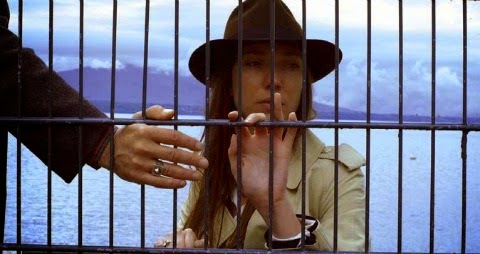by guest writer John Armstrong.
Okay, I'm not saying that you'll "like", or even "enjoy watching" Jean-Luc Godard's Adieu au Langage -- subtitled in English as Goodbye to Language, though that's a tad misleading -- but if you live in DC, or one of the few other places in the country with a theater that might even consider showing it, you should take advantage of the opportunity.
The problem is twofold. First off, the film is arty as hell. I mean really out-there experimental, pushing at the boundaries of what cinema even is. The lack of an MPAA rating alone -- let alone the nudity and general inaccessibility -- means no mainstream theater will touch it. But the most significant boundary Godard pushes here is stereography; this is a 3-D film, and there aren't many art-house theaters around that also happen to have a 3-D projector.
The film is still a narrative, of sorts. There is a story here, not that you're likely to get it all on a first viewing. I certainly didn't. It's here in the same sort of way there's a story in Finnegans Wake, buried in the shifting, dreamlike imagery. With a 3-D television for home analysis, I'm sure a dedicated viewer could mine all sorts of references and dense texture. In a theatrical experience, you just have to let it wash over you, experiencing the film as a whole. It is, in a way, preverbal; language is too highly-processed a tool to discuss this film, and so we must dismiss it.
But vision is also a far more highly-processed tool than we usually think about it. Between taking in the neural firings of arrays of rod and cone cells on two different retinae and experiencing them as a single impression of the world around us, there's a lot more going on than we consciously realize. We think of eyes as passive windows, but they're just the front layer of a deep stack of processing, and we ignore all of it because we've had years of experience making meaning out of the raw sensory input, and it's fed through brains that have evolved for a hundred thousand years as humans, and half a billion years before that as vertebrates. Our eyes just see.
In fact, movies only work because they exploit the quirks of our visual system. The light in a standard film projector actually flickers on and off. The screen is illuminated less than half the time, but our brains blend the flashes together to give the illusion of a constant, moving image.
Stereography is based on another evolutionary quirk: the fact that we have two eyes pointed in almost, but not quite, the same direction. This means that we can infer depth from the slight differences in the images our two eyes capture. A 3-D movie can exploit this by presenting slightly different images to each eye, making the screen look like a diorama behind the frame, or throwing objects out into the audience. And our brain just happily processes the two different images, giving the illusion of depth.
Godard and cinematographer Fabrice Aragno mean to get inside this process and mess with it. When filming in stereo, the camera lenses are not normally separated by more than six centimeters, that being a typical distance between human eyes. Pushing to greater separations leads to greater differences between the images. Our brains struggle to keep up with inputs that suggest an image not just closer than the screen, but within or even behind our heads. Allowing the two cameras to move separately presents our brain with two wildly divergent images, superimposed over each other. Is this how a chameleon sees, or has its brain adapted to process this sort of imagery in a way ours has not?
Our world, as we experience it, is a metaphor, far separated from the literal nature of things. Our culture is just as much a consensual, communal illusion, as exercises like "explain X to an alien" prove. Even in our interactions with each other, our experience is far from literal truth, as we saw in Stories We Tell. From what I could make out, Godard's story explores this same ground between perceptions within a relationship, every bit as fertile as the distance between the projected and received stereo images.
What we perceive is not what is, though we normally assume that it is. We're familiar enough with optical illusions that we can accept their tricks intellectually, though they still affect us physically and we conveniently forget that we're experiencing them. Stereography is a much newer illusion on a commercial scale, and Godard is among the first to really interrogate it with this experiment.
Language is not meaning, but we're more comfortable with this disconnect. It's been a century since the really extreme modernists ripped the novel apart at the seams, and verbal language is a relatively recent illusion anyway, at least as compared with stereo vision.
Godard has pushed at film's illusions his entire career. The jump cuts in À bout de souffle must have seemed bizarre in 1960, but they look normal now; the illusion of time is not so strong that we can't overcome it. It seems that montage is closer to a linguistic illusion than stereography is. Or maybe we can even overcome the illusion of depth. Godard tests not only the edges of stereo vision, but the edges of which illusions we can overcome and which simply shut down our brains when they're violated.
The textual violations of modernist literature rocked the foundations of our sense of narrative, but dramatically expanded the ways we now understand stories, starting with the postmodernists picking through their wreckage. The visual violations of jump cuts destroyed the realist fiction of the early days of cinema, but open up whole new worlds of possibilities for editing. Every illusion we overcome destroys a language, but creates a new one.
Appropriately enough, in Godard's Francophone canton of Switzerland, "adieu" is also used as a greeting. While Adieu au Langage tries to say "goodbye" to the realist conceit of 3-D film, it may well say "hello" to new ways of using the modern technology that has embraced it. Or maybe stereo vision, unlike language and montage, is too deeply rooted in our brains for us to overcome it. Either way, and whether you find value in his attempt or not, you must applaud Godard for the audacity to even try.
Rating: 4 out of 5













